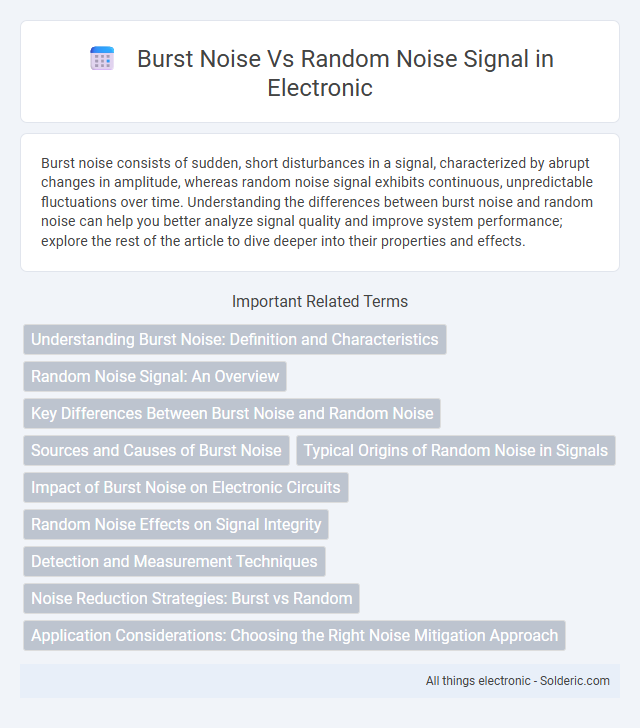Burst noise consists of sudden, short disturbances in a signal, characterized by abrupt changes in amplitude, whereas random noise signal exhibits continuous, unpredictable fluctuations over time. Understanding the differences between burst noise and random noise can help you better analyze signal quality and improve system performance; explore the rest of the article to dive deeper into their properties and effects.
Comparison Table
| Feature | Burst Noise | Random Noise |
|---|---|---|
| Definition | Sudden, discrete jumps or spikes in signal amplitude | Continuous, unpredictable fluctuations in signal amplitude |
| Cause | Material defects, trapping and release of charges | Thermal agitation, shot noise, electronic device randomness |
| Frequency Spectrum | Low-frequency, sporadic events | Broadband, wide frequency range |
| Appearance | Distinct pulses or drops, also known as popcorn noise | Smooth, Gaussian-like distribution |
| Impact | Intermittent errors, signal integrity issues | General background noise, reduces signal-to-noise ratio |
| Mitigation | Device quality improvement, shielding, error correction | Filtering, averaging, signal processing techniques |
Understanding Burst Noise: Definition and Characteristics
Burst noise, also known as popcorn noise, is characterized by sudden, discrete shifts in signal amplitude that occur intermittently, creating a spiky waveform distinct from continuous background noise. Unlike random noise, which exhibits a steady and unpredictable fluctuation of signal levels, burst noise consists of abrupt pulses that can linger for milliseconds to seconds, impacting the stability of electronic circuits. Your ability to differentiate burst noise from random noise is crucial for diagnosing and mitigating signal integrity issues in sensitive applications.
Random Noise Signal: An Overview
Random noise signal, often referred to as white noise, is characterized by its unpredictable amplitude and frequency variations occurring continuously over time. This noise type has a flat spectral density, meaning it contains equal power across all frequency bands, making it prevalent in electronic circuits and communication systems. Unlike burst noise, which appears as sudden, discrete spikes, random noise maintains a steady, statistically random pattern that can degrade signal quality and system performance.
Key Differences Between Burst Noise and Random Noise
Burst noise, characterized by sudden, discrete spikes or pulses, contrasts sharply with random noise, which presents as continuous and unpredictable fluctuations. Burst noise often arises from defects in semiconductor devices and has distinct onset and duration, whereas random noise originates from thermal agitation or shot noise and exhibits a steady, Gaussian distribution. The key difference lies in the temporal behavior and statistical properties, with burst noise showing intermittent, high-amplitude anomalies and random noise displaying consistent, low-amplitude variation.
Sources and Causes of Burst Noise
Burst noise originates primarily from defects or impurities in semiconductor materials, causing sudden, discrete shifts in current or voltage levels within electronic devices. Sources include trapping and release of charge carriers at defect sites in transistors and resistors, leading to sporadic, high-amplitude fluctuations. Unlike random noise, which is continuous and arises from thermal agitation of charge carriers, burst noise is characterized by intermittent, abrupt transitions linked to microscopic material imperfections.
Typical Origins of Random Noise in Signals
Random noise in signals typically originates from thermal agitation of electrons, shot noise caused by discrete charge carriers crossing a junction, and flicker noise arising from material defects or imperfections in electronic components. These noise sources introduce small, unpredictable fluctuations in voltage or current, affecting signal fidelity. Understanding these origins helps you design circuits and systems that minimize noise impact and improve signal quality.
Impact of Burst Noise on Electronic Circuits
Burst noise, characterized by sudden step-like transitions in voltage or current, introduces unpredictable disturbances in electronic circuits, leading to signal integrity degradation and increased error rates. Unlike random noise, which follows a Gaussian distribution and is relatively easier to filter, burst noise significantly affects precision analog and low-frequency applications such as sensor interfaces and communication systems. Its impact includes reduced signal-to-noise ratio (SNR), lowered reliability, and potential malfunction of sensitive semiconductor devices.
Random Noise Effects on Signal Integrity
Random noise, commonly referred to as white noise, introduces unpredictable fluctuations in voltage or current that degrade signal integrity by causing errors in data transmission and reducing signal-to-noise ratio (SNR). Its continuous spectral presence affects the entire frequency band, making it challenging to filter out without impacting the desired signal. These stochastic perturbations contribute to bit errors, jitter, and timing inaccuracies in communication systems, necessitating robust noise mitigation techniques for maintaining reliable signal performance.
Detection and Measurement Techniques
Burst noise detection relies on time-domain analysis using techniques such as threshold crossing and pulse counting to capture transient spikes, while random noise signal measurement employs power spectral density (PSD) analysis and root mean square (RMS) calculations to quantify continuous background fluctuations. Advanced oscilloscopes and spectrum analyzers enable precise characterization of burst noise events by visualizing sudden amplitude changes, whereas random noise is often assessed through statistical models that extract noise floor and bandwidth parameters. Understanding these distinct detection and measurement methods ensures accurate evaluation of Your signal integrity and device performance.
Noise Reduction Strategies: Burst vs Random
Burst noise reduction focuses on detecting and isolating sudden, high-amplitude pulses through threshold-based gating and waveform shaping techniques, effectively minimizing its impact on sensitive electronics. Random noise reduction employs filtering methods such as low-pass, band-pass, and adaptive filters to suppress wideband stochastic fluctuations, improving signal clarity in communication systems. Combining burst noise gating with random noise adaptive filtering enhances overall noise suppression in mixed-signal environments.
Application Considerations: Choosing the Right Noise Mitigation Approach
Burst noise, characterized by sudden step-like signal changes, requires targeted mitigation techniques such as clipping or burst error correction in communication systems to maintain signal integrity. Random noise, often Gaussian-distributed, benefits from statistical filtering methods including low-pass filters and averaging to reduce its pervasive, continuous interference in audio and radar applications. Understanding the noise type ensures optimized noise reduction strategies, enhancing system performance and reliability across diverse electronics environments.
burst noise vs random noise signal Infographic

 solderic.com
solderic.com